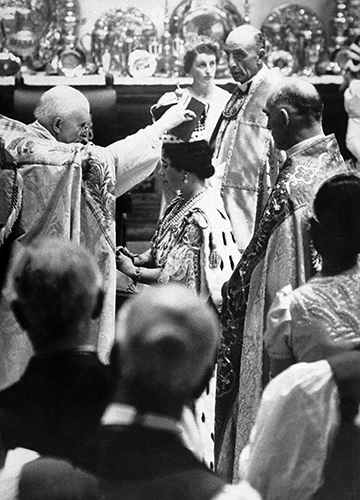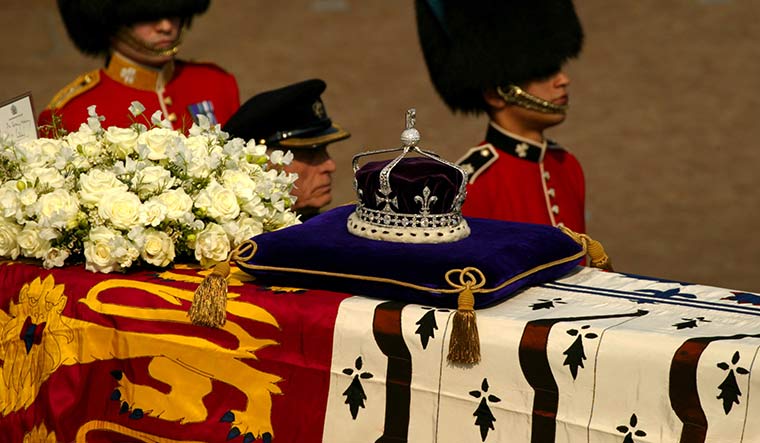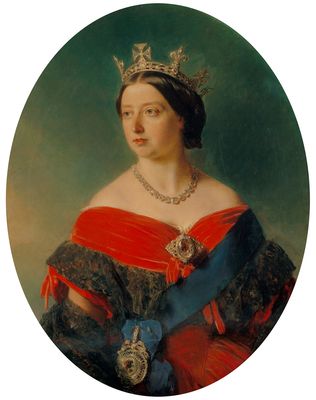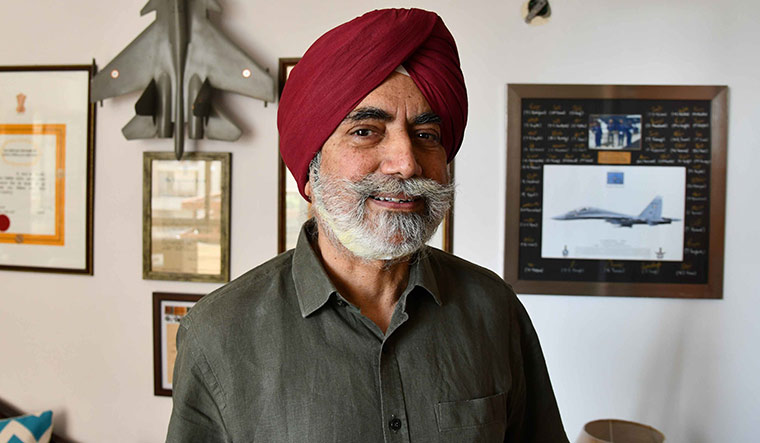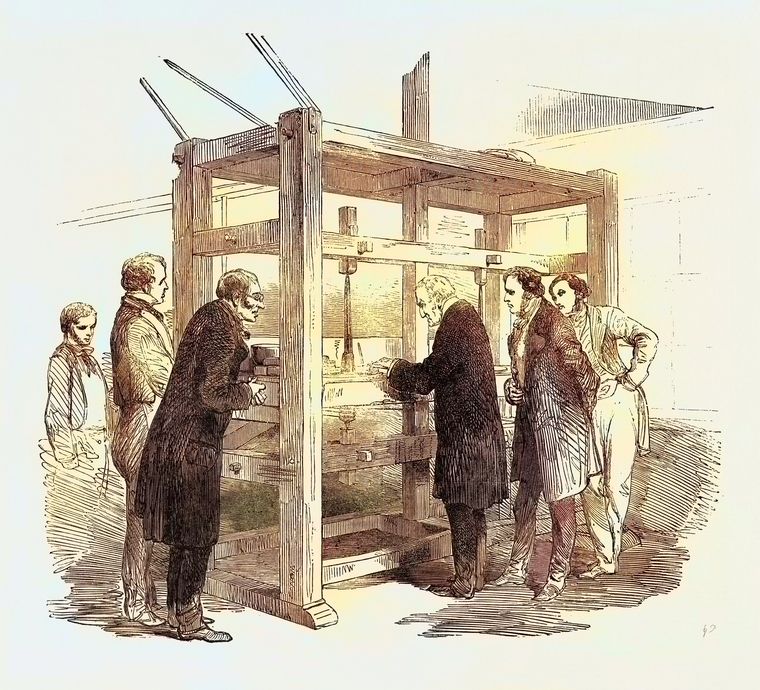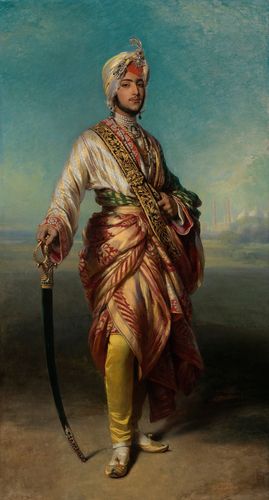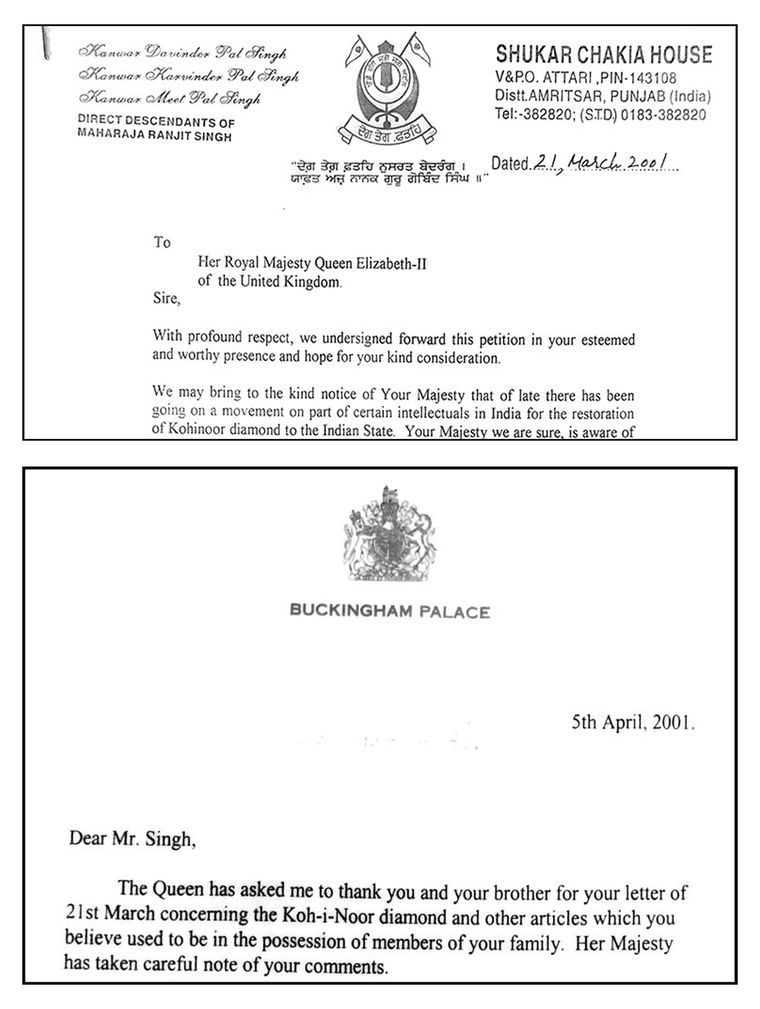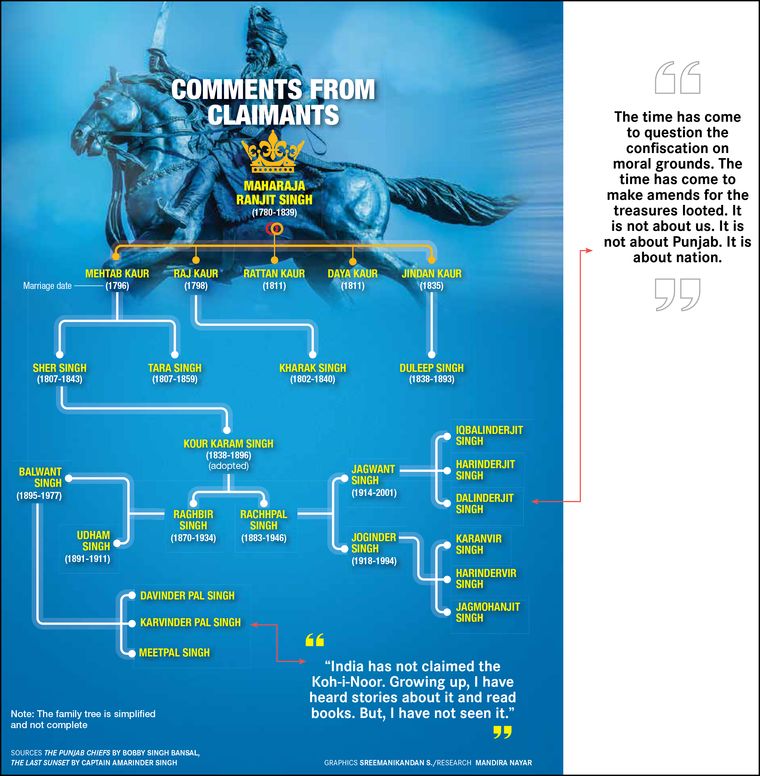The first time he saw it was also the last. In 2000, Kanwar Dalinderjit Singh stood in a queue outside the Tower of London to see the stone that has defined his family. The Koh-i-Noor, the most famous diamond in the world. It is the star in the crown of Queen Elizabeth, the Queen Mother. It is a fabled stone; and a cursed stone, nonetheless.
Its associations with royals began much before it reached Britain. It was strapped on an amulet that Maharaja Ranjit Singh, the Lion of Punjab and first ruler of the Sikh Empire, jauntily wore to impress the firangis—successfully, too, turning Lord Dalhousie into Gollum. It is much smaller now than when Dalinderjit’s great great-grandfather Sher Singh, Ranjit Singh’s son from his first marriage, had worn it to establish his claim to the throne during a bloody Game of Thrones moment in Punjab in the 19th century. Today, the Koh-i-Noor and the story of the ‘Black Prince’ Maharaja Duleep Singh, who “gifted” it to Queen Victoria, is as well-polished as its dazzling surfaces.
The Koh-i-Noor’s story is very much crafted like its myth. It is said that it was like an egg when it arrived in Britain. Prince Albert, the consort of Queen Victoria, had his task cut out to make the diamond live up to the expectations of the British people—they breathlessly waited to catch a glimpse of it when it was at the Great Exhibition at Crystal Palace in 1851. It did not shine brightly enough; enveloping it in pink fabric and placing it in a cage lit by half a dozen gas lamps did the trick.
If Helen of Troy’s face launched a thousand ships, the Koh-i-Noor had the power to begin—and end—empires. The colonial conquest of India has had its share of emotive moments, a sort of montage of symbolic moments of capture—the Battle of Plassey (1757), the siege at Seringapatnam with Tipu Sultan (1799) and the Last Treaty of Lahore (1849) and with it the surrender of the Koh-i-Noor. “I have caught my hare,’’ writes Dalhousie. “The Koh-i-Noor has become in the lapse of ages a sort of historical emblem of the conquest of India. It has now found its proper resting place.”
Kept behind glass, the Koh-i-Noor has been tamed, resized to take the flaw out of its heart. “It now sparkled brilliantly, but it could lie meekly in the palm of a hand,’’ write William Dalrymple and Anita Anand in Kohinoor—The Story of the World’s Most Infamous Diamond. But its power still holds. Even now, the Koh-i-Noor is an emotive issue. If the British public lined up to catch a glimpse of the fabled stone at the Great Exhibition, now in the post-Raj era, there are queues of South Asians like Dalinderjit wanting to see it and claim it as stolen. “They didn’t even allow a camera,” says Dalinderjit, who is a retired air marshal. “You get on a travelator and by the time you have registered it, you have zoomed past.”
In 1947, India asked for it back. There was also a claim by the Congress to send it to the Jagannath Temple at Puri. Ranjit Singh, on his deathbed, had indicated that the diamond must be sent there. But Misr Beli Ram, his loyal treasurer, chose not to obey this dying wish and instead kept it for the Sikh state. Much later, the British government, having lost the empire, was unwilling to lose the jewel in the crown. As per Kohinoor, “The British government stated that the diamond had been formally presented to the then sovereign Queen Victoria, by its rightful owner, the Maharaja of Lahore. To draw a line under the matter, the government added that this situation was ‘non negotiable’.”
Any attempts to bring it back subsequently—fuelled by nostalgia, an acknowledgement of injustice of the past—have failed. There was little hope of anything from the colonial loot ever being returned, that is till November 2021.
The world—at least for museums—changed, courtesy France and President Emmanuel Macron. It started with him declaring in 2017 in Burkina Faso that France would return African artefacts to Africa. Three years later, in a Covid-stuck, more-woke world—rocked by Black Lives Matter—this promise became a reality when France sent back 26 Beninese treasures. The arrival of the artefacts in Nigeria marked a moment as historic as when they were looted. It has offered the tangible possibility of the return of cultural goods home.
The stripping of the Benin Bronzes—a collection of metal and stone works that dates back to the 13th century—occurs in 1897 as “legitimate spoils of war”. It is very much a classic colonial story. James Robert Phillips, the vice consul-general, on a mission to overthrow the Oba (king), travelled to Benin with six officers—two translators—and 215 porters. They announced their intentions to visit the city, but were told that they had to wait as rituals were being conducted and no foreigners were allowed during that period. Phillips ignored the advice and was massacred. Only two Europeans survived to tell the tale. Eight days later, there was a full-fledged naval retaliation—the city was sacked and art that had decorated the homes of the Benin nobility were carted away. Just to offer a glimpse into the mass-scale pillage: over 900 pieces are now in the British Museum, and over 440 in Berlin alone, among others. Now centuries later, the return legitimately by France has opened the door for a word that was lethal for Oliver Twist, too: more. Repatriation—taboo for years—has now been made possible.
The University of Aberdeen in Scotland has chosen voluntarily to return its lone Benin bronze. Earlier this year, the Smithsonian Museum became the largest institution to promise to give back the Benin pieces. The museum has instituted a new policy that restitution bids will be considered through an ethical prism rather than a legal one. In April, Glasgow Museums announced the return of 17 Benin artefacts, apart from seven Indian ones. Germany, too, has pledged to give back artefacts. And, this is likely to be just the beginning.
The clamour for the return of the loot, too, has got louder. Greece has always been at the forefront, demanding that the Parthenon Marbles—stolen and spirited away by Lord Elgin—be returned. Turkey formed a parliamentary committee to take stock of the treasures that exist in Europe. There has been some success—more than 4,000 artefacts have come home since 2003. Cambodia has written a letter to Britain asking for artefacts that left the country during the Khmer Rouge regime. Nigeria, having tasted success with the Benin Bronzes, is determined to take the fight further.
It has set a precedent, a dangerous idea in museums. Not only for the symbolism of the act—the return of cultural loot to its rightful place—but for introducing a barely heard-of concept into the world of museum collection—morality. It also goes beyond the 1970 UNESCO Convention on the Means of Prohibiting and Preventing the Illicit Import, Export and Transfer of Ownership of Cultural Property.
“There is now a growing support internationally for the return of cultural goods wrongfully taken away,’’ says renowned human rights lawyer Geoffrey Robertson. “China has been demanding its stuff back. France is returning artefacts taken from Africa. Museums, apart from the British Museum, have returned artefacts. This is the time. Greece is contemplating going to the International Court of Justice for the marbles.”
The tide has turned. In 2020, the Netherlands promised to give back any object that may have been stolen. “In the Netherlands, there is a lively debate [about colonialism],” says Venu Rajamony, former Indian ambassador to the Netherlands. “The government has a clear policy that if there is any stolen property in their museums, it will be returned to the country concerned.” The principle laid out by a committee led by lawyer and human rights activist Lilian Goncalves-Ho Kang You was simple: acknowledge the injustice of colonialism and be willing to return the objects if they were acquired involuntarily.
“The return of the Benin Bronzes is a landmark moment,’’ says Martine Gosselink, general director, Mauritshuis Museum in The Hague, Netherlands. “I also want to say that every case is different. So, what counts for object number A will not count for object number B because it has a different story, a different history and complexities. So for me, that’s a very, very important remark to make.”
The only place that remains stubbornly unmoved by the spate of voluntary returns of objects is Britain. “The British Museum does not always respond to requests for provenance,’’ says Amareswar Galla, a UNESCO chair on inclusive museums, and founding director, International Centre for Inclusive Cultural Leadership, Anant National University, Ahmedabad.
Repatriation is now a political force. Jamaica demanded billions of pounds from Britain. The sheer power of this anti-colonial moment was felt as Prince William and Kate, the two most hardworking royals, faced protests during their tour of the islands in March. The writing on the wall is clear. And, as William realised, expressing “sorrow” may just not be enough. Like the blood on Lady Macbeth’s hands, the stain of slavery is difficult to wash off.
This change comes at a time when India steps into its 75th year of independence. It is fiercely determined to reengage with its past, and actively rewrite it. The return of objects has become a plank the government has chosen to take seriously. More than 200 objects have found their way back home to India. But none of them have been colonial loot. For a government deeply committed to a justice-in-the-present for the past, the Koh-i-Noor is a perfect case. The questioning of the British empire has very much been on the menu since Congress MP Shashi Tharoor’s Oxford Union speech in 2015 went viral. There has also been an examining of the past, zealously from a religious prism, and a frenetic need to fix it. For it to be meaningful, it is only right that the grand prize should be claimed, too, even if it is a way to begin a conversation for getting back the loot.
“The issues are bigger,” says Dalinderjit. Treaties and their adherence are an essential fabric of his ethos. As a military man, he accepts the treaties signed, but believes that the Koh-i-Noor was never surrendered. “The time has come to question the confiscation on moral grounds,” he says. “The time has come to make amends for the treasures looted.” His family has lived with a list of items taken away—the Koh-i-Noor went of course, but so did much more. A list of everything that went, carefully noted down and signed, still exists. “We have the original; it is in Farsi,’’ says Kanwar Karvinder Pal Singh, another descendant of Ranjit Singh who lives in Attari. Nothing ever came back. The loss extended beyond what just belonged to the state. In March 2001, he sent a letter to the Queen, laying claim to the diamond and asking for it to be sent to the Golden Temple. He got a reply which said the Queen had “taken careful note”of his comments.
It is a tall order getting back the diamond. Especially, as India has swung between appeasing popular opinion and shying of claiming it diplomatically. “There is no clear cut diplomatic position on the Koh-i-Noor,” says Navtej Sarna, former high commissioner to the UK and author of The Exile, a fictionalised account of Duleep Singh’s life. “But this may be a good moment for developing one.”
In 2016, the Indian government claimed that the Koh-i-Noor was loot and was part of the Treaty of Lahore. Then solicitor-general Ranjit Kumar, in an affidavit, claimed it was “neither stolen nor forcibly taken’’, making it pointless in trying to get it back. This was in response to a public interest litigation. A meeting was hurriedly called by then minister of external affairs Sushma Swaraj to fix the situation. In a U-turn—the kind that can only be executed by the government in court—the Archaeological Survey of India claimed that that the government was making “all possible efforts to bring back the Koh-i-Noor diamond in an amicable manner”. It added, however, that there were no legal grounds to get the diamond back. The only convention that exists was the 1970 UNESCO convention; anything prior did not apply. With the legal route no longer valid, the ASI claimed that the matter was being pursued diplomatically.
So far this conversation—an essential one—has not happened. India needs to ask for the Koh-i-Noor to remember its past. Its dazzle hides a heart of darkness: the grubby story of a diamond that is taken from a little boy, alone and terrified. Could the Koh-i-Noor become a point—a political one—to talk about the empire and to ask for the return of other objects of plunder? “India has to begin by asking for the diamond,’’ says Robertson.
The demands from Indian shores apart, the Koh-i-Noor—which is intrinsically tied up with Maharaja Ranjit Singh, his kingdom and his son in exile Duleep Singh—has now become very much an emotive issue in Britain. The Sikh diaspora is looking for their roots and their engagement with their country of origin and country of birth. Duleep Singh—buried in Elveden, far away from home, and very much Christian—is a poignant symbol caught between two worlds. It provides the perfect backdrop to explore this relationship. And, it is finding an expression in Britain.
In 2020, in a poll conducted by the BBC, Maharaja Ranjit Singh was voted the greatest world leader of all time. According to the poll, his empire “marked a golden age for Punjab and northwest India”. Winston Churchill came third. Growing up in Britain, without a role model, councillor Bobby Singh Bansal has devoted his life to documenting the history of the Sikh court. Apart from the four books he wrote, Bansal also installed statues of Ranjit Singh in Lahore and in Saint-Tropez in France, where his close friend and general Jean Francois Allard came from. The diaspora may not support the return of the diamond to India, but they do want the story of its acquisition to be told accurately, and not in sepia-tinged Raj nostalgia.
At the heart of the Koh-i-Noor—apart from its romance, glitz and glamour—is the story of the young boy from whom it was taken. Duleep Singh, barely 10, is separated from his mother, Jindan Kaur—depicted by Dalhousie as promiscuous and a threat—and is shipped to England. There, he is ‘adopted’ by the Logins, a British couple. “Because Punjab was the last biggest state to be conquered, the British hammered it down,” says Sikh scholar Gurinder Mann. “They broke the psyche. They Christianised the only surviving member of the Ranjit Singh family.’’
Duleep was more of an English gentleman most of his life. In the mornings, he would shoot, and in the afternoons, spend time fighting back for his personal property. He lived beyond his means. By the end of his life, he was a rebel determined to go back to India, but stopped by the British. He tried to rally support from the Germans. He died heartbroken and far from rich in Paris.
“The loss of the Koh-i-Noor had always hurt him deeply,’’ write Dalrymple and Anand in their book.
Also read
- India has not done enough to bring back Koh-i-Noor: Geoffrey Robertson
- Why it is difficult for India to reclaim Koh-i-Noor
- The British duped us: Bobby Singh Bansal
- Can India bring back artefacts looted before independence?
- How a forgetful British civil servant nearly lost Koh-i-Noor
- University of Aberdeen leads the way in returning artefacts to their rightful heirs
On July 10, 1854, Duleep is at Buckingham Palace, being painted by the court painter Franz Xaver Winterhalter. He is dressed up in finery, the only item missing is the Koh-i-Noor, which had been strapped on him as a child. Victoria had not worn it either. The next day, she brought it out to show him. He held it in his hand, bowed and put it in her hand. “It is to me, Ma’am, the greatest pleasure to have the opportunity, as a loyal subject, of myself tendering to my Sovereign—the Koh-i-Noor,” goes the incident in the book.
This moment, very much a testimony of loyalty, has been passed down in Britain as proof of ownership. But each time that story is told, it is important to remember the woman who the British wrote out of history—his mother Jindan. “In December 1847, when the maharaja was barely nine years old, he was sent to the Shalimar Garden while Jindan was torn screaming from the palace,’’ note Dalrymple and Anand. “She fought as she was dragged away, begging the Sikh men around her to wake up and fight…. Not one man lifted a finger to help her.” Imprisoned in Sheikhupura, she begged the British for her son. “I cannot bear the pain of this separation. Instead put me to death…. I will accept what you say. There is no one with my son. He has no sister, no brother. He has no uncle, senior or junior. His father, he has lost. To whose care has he been entrusted?’’ For years, Jindan was kept away from her son. Her letters were destroyed. When she finally saw him, she was practically blind. The story goes that she touches his face and his hair and wept.
Each time the Koh-i-Noor is invoked, the story of its acquisition must be the elephant in the room. If nothing else, India needs to ask for that—to find a way to fit what the loss of the diamond meant for Jindan, more than a loss of a kingdom. The loss of her son. “The history should be corrected,’’ says Peter Bance, a Sikh scholar who has spent his years chronicling the life of Duleep Singh. “Even in the Black Lives Movement, I was not in favour of pulling down statues, but putting in plaques. So that we remember and these mistakes don’t happen again.”
So that finally when the Duchess of Cornwall dons the crown as Queen, she must feel its weight of history.


